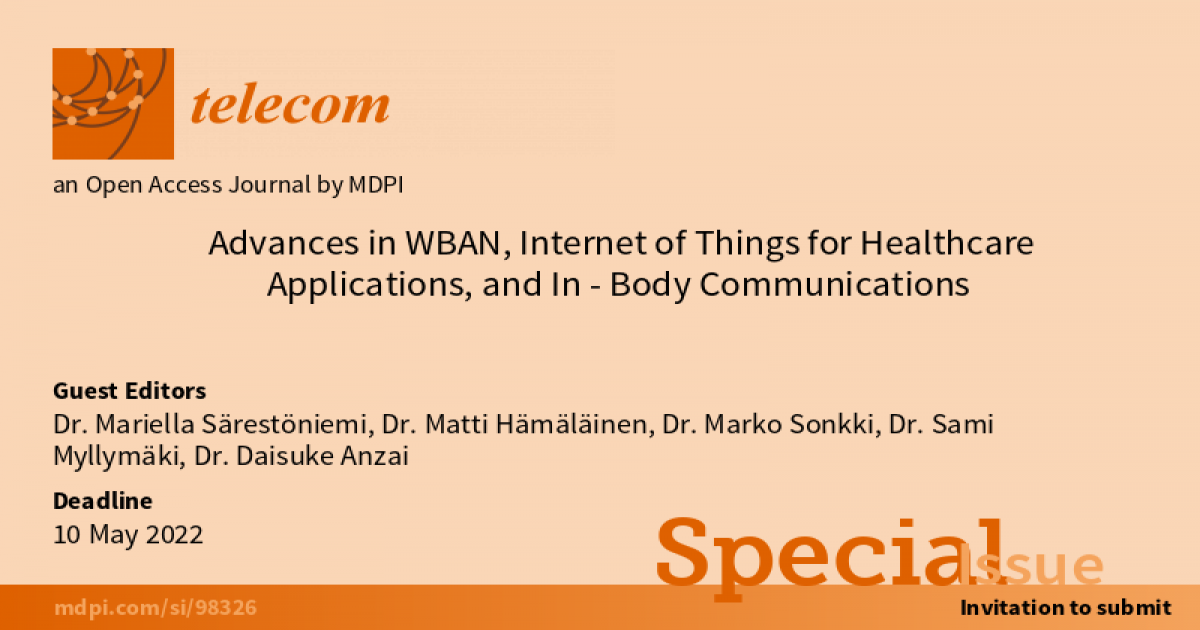- 2.4Impact Factor
- 5.4CiteScore
- 27 daysTime to First Decision
Advances in WBAN, Internet of Things for Healthcare Applications, and In-Body Communications
Special Issue Information
Dear Colleagues,
Interest in advanced healthcare systems has increased significantly, motivated partially by their potential to address widely recognized challenges related to the loaded healthcare in growing cities, aging population, and equality in rural area healthcare. Several significant prospects together with related requirements, such as high quality of service, enabled mobility, reliability, safety, and security, have motivated intensive research on wireless body area networks (WBANs) and the Internet of Things (IoT) in general for healthcare applications. Active research has especially been carried out in on- and in-body communications.
This Special Issue invites submissions of high-quality unpublished research articles on the recent advances of WBAN, IoT for healthcare, and in-body communications. We welcome for submission of theoretical or experimental studies as well as review articles.
Topics of interest include but are not limited to:
- Antenna design and simulation methods;
- Propagation and channel modeling;
- Materials and device fabrication methods;
- Transceiver design and performance evaluations;
- In-body and intra-body communications;
- Network architectures;
- Security;
- Standardization;
- Experimentation and RF measurement methods;
- Wearable computing;
- EMC on wearable/in-body/intra-body communication systems;
- Localization for medical implants.
Dr. Mariella Särestöniemi
Dr. Matti Hämäläinen
Dr. Marko Sonkki
Dr. Sami Myllymäki
Dr. Daisuke Anzai
Guest Editors
Manuscript Submission Information
Manuscripts should be submitted online at www.mdpi.com by registering and logging in to this website. Once you are registered, click here to go to the submission form. Manuscripts can be submitted until the deadline. All submissions that pass pre-check are peer-reviewed. Accepted papers will be published continuously in the journal (as soon as accepted) and will be listed together on the special issue website. Research articles, review articles as well as short communications are invited. For planned papers, a title and short abstract (about 250 words) can be sent to the Editorial Office for assessment.
Submitted manuscripts should not have been published previously, nor be under consideration for publication elsewhere (except conference proceedings papers). All manuscripts are thoroughly refereed through a single-blind peer-review process. A guide for authors and other relevant information for submission of manuscripts is available on the Instructions for Authors page. Telecom is an international peer-reviewed open access semimonthly journal published by MDPI.
Please visit the Instructions for Authors page before submitting a manuscript. The Article Processing Charge (APC) for publication in this open access journal is 1200 CHF (Swiss Francs). Submitted papers should be well formatted and use good English. Authors may use MDPI's English editing service prior to publication or during author revisions.
Keywords
- implant communication
- implant localization
- Internet of Things for healthcare
- Internet of Medical Things
- antennas and propagation
- materials
- network architectures
- radio channel modeling
- security
- standardization
- in-body communications

Benefits of Publishing in a Special Issue
- Ease of navigation: Grouping papers by topic helps scholars navigate broad scope journals more efficiently.
- Greater discoverability: Special Issues support the reach and impact of scientific research. Articles in Special Issues are more discoverable and cited more frequently.
- Expansion of research network: Special Issues facilitate connections among authors, fostering scientific collaborations.
- External promotion: Articles in Special Issues are often promoted through the journal's social media, increasing their visibility.
- e-Book format: Special Issues with more than 10 articles can be published as dedicated e-books, ensuring wide and rapid dissemination.

